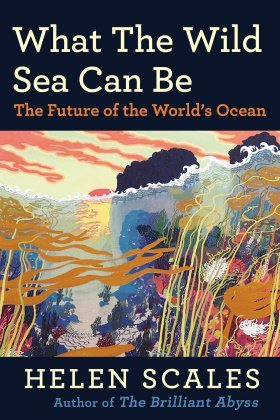c The ISA comprises 167 member states and the European Union.
d The UK government dragged its heals on the matter, amid considerable pushback including from those in power. For instance, in a letter to The Times in July 2023, former Conservative Party leader William Hague wrote: “The right question to ask at the International Seabed Authority is not ‘Shall we find a way to do this?’ but rather ‘Are you completely mad?’” Finally, in October that year, the UK government capitulated and announced its support for the proposed moratorium on mining licenses.
e The United States is not a member of the ISA and so does not attend these meetings.
Epilogue
Not long ago, I went swimming at one of my favourite spots in Brittany, where I scramble over rocks, pull on a dive mask, and slip into the cold sea to explore the seaweed-covered rocks, search for the tiniest cowrie shells, and watch for the tails of pipefish twisting through the greenery. It was the eighth of August, a perfect date because for the first time after several years of exploring this part of the French Atlantic coast, I saw an octopus.
It caught my attention with a wave of one of its eight arms, and before my conscious mind had time to register what it was, the inner voice that always narrates my underwater explorations silently called out, Suckers! If I hadn’t seen that supple, tapering arm with circular suction cups lined up along it, largest at the body end and leading to impossibly tiny ones at the tip, I’m sure I would have missed the octopus entirely. It shrank into the seaweed garden and became almost invisible, matching its skin colour and texture to its surroundings. All I could make out was one eye watching me, white with a horizontal black iris striped across it.
That octopus encounter, and another I had a little while later, sum up for me the strange hybrid mix of glories and troubles of the Anthropocene ocean.
It was a common octopus. Historically, it was considered a single, cosmopolitan species living in disjointed populations in temperate seas across the globe. However, recent studies of its genes revealed the common octopus to be what’s known as a cryptic species complex, a group whose members all look alike but are dissimilar enough at a molecular level to count as separate species, in this case at least six octopuses that live along different coastlines around the world. Octopuses that live in the Mediterranean and in the Atlantic between North Africa and the English Channel have kept the original name, Octopus vulgaris. Others have been assigned new names, including Octopus americanus in the Americas; Octopus djinda and Octopus tetricus in southwest and southeast Australia, respectively; and Octopus sinensis in the East China Sea. These species are all sensitive to climate change in slightly different ways, which means that in future warmer seas, some will do better than others. Some octopuses are predicted to lose only small parts of their habitats where the waters will become too hot for them. Some species are expected to shift towards the poles. And some could disappear from large parts of their current range. By the end of the century, unless carbon emissions are brought down, species from this cryptic complex could be lost entirely from the Caribbean and the Indian Ocean island of Madagascar, where octopus fisheries are a significant source of food and income.
Over the past forty years, the global catch of octopuses has doubled. As other ocean species have become overexploited, octopuses are increasingly taking their place in seafood markets. There are also plans to begin farming Octopus vulgaris for food, despite huge worries about the ethics and ecological impacts of mass-rearing these highly intelligent and notoriously solitary predators. A company in the Spanish Canary Islands intends to produce a million octopuses a year in a thousand communal tanks inside a two-storey building at the port of Las Palmas. The animals will be killed by plunging them into freezing water, a method that is untested in octopuses but has been shown to cause a slow, cruel death in fish.
I choose not to eat octopuses, for various reasons including that thoughtful look in their eyes. That’s not to say that I think nobody should eat them. It is possible to catch wild octopuses sustainably and ethically. But that’s not what’s happening in Brittany. When huge numbers suddenly appeared along the coast in 2021, an octopus-fishing bonanza began. Before then, octopuses were not a common sight along the northwestern coast of France. Within a couple of years, fishers were catching hundreds of tons and earning a fortune selling them to fish markets in Spain (for now, there’s no appetite for poulpes in Breton cuisine). Nobody yet knows exactly what caused this population boom, or how long it might last, but it has happened before. At the very end of the nineteenth century, there was an octopus frenzy in southern England and northern France. The London Fishing Gazette reported in October 1900 that octopuses had been so abundant along the Brittany coast the previous year that it was almost impossible to turn over a stone on a beach without finding one or more hiding underneath. After a storm, hundreds of dead octopuses washed up on the shore and were carted away to sell as manure.
Another British newspaper explained in 1900 that the presence of so many octopuses was due to the “excessive heat of recent summers.” Warming seas today, especially during the winter months, could have a part to play in the rise of octopuses around the coasts of France and England, potentially allowing more of their larvae to survive and grow to adulthood. Another factor could be a general lack of large predators in the region, such as seals and dolphins, which might otherwise have kept octopus numbers in check. While a direct link can’t be drawn, it’s a poignant fact that while octopuses are plentiful in France, dolphins have been washing up dead and mutilated along the same stretch of coastline, likely after they were caught and drowned in industrial trawl nets and then dumped over the sides of fishing vessels.
In the late 1890s, British and French fishers complained bitterly about the surfeit of octopuses stealing their catches of crabs, lobsters, and oysters, describing them as pests and loathsome beasts. More than a century later, fishers in Brittany are again infuriated that these eight-armed cephalopods still have a fondness for feasting on catches inside fishing nets and traps.
I witnessed this brazen habit a few days after seeing that first octopus. I took my nephew and his partner for a snorkel at the octopus spot, hoping we might get lucky and see it again. We searched through the seaweeds, and I pointed out sea stars and blue-rayed limpets, but we didn’t spy any seaweed mimics watching us back. My nephew did, though, come across a cluster of abalone on the sand, and he dived down and picked up a half dozen big, gleaming shells. Until then, I had only ever seen live abalone a few times and had never found such large, intact shells; they’re flattened and ear-shaped, and these ones fit all the way over my ear with room to spare.
The abalones we found were treasure enough, so we headed back towards the beach. On the way, my nephew’s partner was the first to spot the fish trap resting on the kelp a few feet from the surface. Sitting inside was a large red octopus. Several of its arms were wrapped around chunks of bait, including a fish’s head and tail. The octopus could easily have climbed out of the trap, but it seemed content where it was, surrounded by its free feast. For long, peaceful minutes, we watched the octopus in stunned silence, while it huffed and breathed through its siphon tube, and we held tight to our abalone shells. I now keep one of them on top of the piano, where the light catches its oily, iridescent interior and casts bright dots through the row of eight holes through which the living abalone reproduced, pooped, and breathed—right up until the moment it was prised off a rock by, I bet, a strong, suckered arm. The pile of shells we found on the seabed must have been a midden of the leftovers from abalone feasts, piled up outside an octopus’s den. I like my shell all the more knowing that the creature inside was probably eaten by an octopus. I’ll go back next summer to see if I can find some more.

Gannets diving for fish, Shetland, Scotland

A lionfish, an introduced species now stirring troubles in the western Atlantic and Mediterranean


In 2017 in Atka Bay, Antarctica, an adult emperor penguin (above) makes a desperate leap into the sea after being trapped on a high ice shelf when the sea ice melted earlier than normal. Without a full coat of adult feathers, a lone chick (below) won’t survive the jump.

Critically endangered oceanic whitetip shark

Species seen in a cubic foot of coral reef during a 24-hour period, Mo‘orea

Endangered Nassau groupers gather to spawn

Mangroves and seagrasses nurture life and protect coastlines

Almaco jacks hunt in a floating sargassum forest, Sargasso Sea

At 130 feet, rebreather divers explore a mesophotic coral reef in Tahiti

Black rockfish shelter in a Pacific giant kelp forest

Octopus seen by the author, Brittany, France

Critically endangered sunflower sea star


























